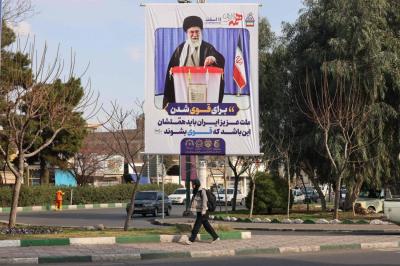The end of Mohammad Khatami's presidency on August 3, 2005, and the assumption of Mahmoud Ahmadinejad as the head of the executive authority formed the last link in the system's efforts to control the centers of decision-making in the state. This followed months of the regime's forces seizing legislative power in the elections held on May 27, 2004, leading to the three branches of government (executive, legislative, and judicial) falling under the grip of the conservative and regime-affiliated faction.
Simultaneously, contrary to the conservative rise and the Islamic state rhetoric, this date marked the beginning of the dwindling and retreat of the reformist discourse along with the parties and forces advocating for reforms, under the blows of the power structure and its security and political apparatus. The experience of the "Green Revolution" and the candidacy of Mir Hossein Mousavi in June 2009, which attempted to assert their existence and role in Iranian society against the regime’s forces, provoked a severe backlash from the regime, plunging them into a state of political obscurity, which nearly turned into a state of clinical death, so to speak.
In the past two decades, reformists faced a clear inability to repair their communication channels with social classes, particularly regarding their attempts to keep the reformist discourse present and influential in social circles. The substantial gap became evident, deepening significantly during the recent events in Iran in September 2022 following the death of Mahsa Amini at the hands of "morality police" elements. Reformists discovered that the youth forces, who were expected to carry their discourse and project, had moved elsewhere, with a new generation that had outgrown their conciliatory approach to a stance that boldly demanded systemic change, realizing that their attempts to reconcile the theocratic authority with republican mechanisms no longer met their aspirations.
This was the moment that Mir Hossein Mousavi seized to challenge Khatami and all reformist leaderships by calling for the formation of a constituent assembly and a change to the Iranian constitution. The decision by the Guardian Council to accept the candidacy of Masoud Bezhsky as a direct candidate for the reformist front seemed like a "shot from a non-shooter," which served the interests of the reformist and moderate discourse, awakening a shock that brought them back into the political spotlight, rearranging their position within a political landscape that had become accustomed to their decline due to being besieged by the regime and its tools.
At first glance, reformist and moderate forces may appear imbalanced, believing in the difficulty of this return, especially since they directly challenged the power structure by conditioning their participation in elections and voting rights on having their candidate publicly acknowledged. This moment was seized by the Guardian Council and decision-making circles to employ this stance to raise the level of popular participation in the electoral process, enabling them to gauge the remaining popular bases for reformist forces and utilize them to restore their representative legitimacy, which the Supreme Leader regarded as the strongest card in facing "Iran's enemies."
The regime's pragmatism towards revitalizing reformist forces and allowing their return to be active in the political scene, within the limits set for this return, was matched by a clear pragmatism from these forces regarding their participation in the electoral race. The electoral discourse they began focusing on clearly tilted towards political and social "realism." Therefore, their bet on achieving a significant victory would breach or undermine all accumulated efforts made by regime forces to monopolize power, governed by this realism. The immediate goal of this election would primarily be to rebuild trust with the social classes that had distanced themselves from them, and secondly, to take advantage of the heated competition among conservative candidates, which could turn into a "battle of attrition" between the hardline Salafi wing represented by Saeed Jalili and the official traditional conservatives represented by Mohammad Baqer Qalibaf, in order to improve their conditions and project within the electoral and political scene.
Reformist pragmatism does not seem limited to dealing with conservatives or confined to electoral battles with opposing candidates. Indicators from reformist leaderships reveal a new type of political realism in addressing the Supreme Leader, who is considered by them to be the primary accused responsible for the exclusionary policies directed against them in past years. The electoral discourse promoted by these forces at this stage attempts to separate the electoral battle from the Supreme Leader, thus seeking to avoid provoking him in a manner that would derail this initiated path, prompting him to take an escalatory step from outside the context that would push them out of the electoral process.
This pragmatism or realism reflects a different political awareness among reformist factions, which they strive to emphasize in their electoral campaign, addressing their supporters and undecided voters. This conviction resulted from a buildup of experiences during their time in power under Presidents Khatami and Hassan Rouhani, leading to an understanding that radical changes in the regime's internal and external strategic policies are not possible, thus focusing instead on the available space to practice reformist policies within the domestic socio-economic and financial contexts, and ultimately seeking to maintain a good and non-tenuous relationship with the Supreme Leader, accepting the limits he sets for the role of the executive authority, whether reformist or conservative.




